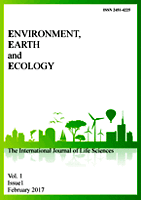| 1. |
Amini S, Homayouni S, Safari A, Darvishsefat A (2018) Automatische Erkennung von Oberflächenmaterialien städtischer Objectekte. Geo-spatial Information Science, Volume 21 - Issue 2.
|
| 2. |
Antal J, Igaz D (2018) Aplikovaná agrohydrológia. 8. vyd. Nitra: Slovenská poľnohospodárska univerzita, 210.
|
| 3. |
Feng L, Han L, Liujun Z, Huang Y, Song G (2020) Urban vegetation mapping based on the hj-1 NDVI reconstruction. Remote Sensing and Spatial Information Sciences, Volume XLI-B8, 2016.
|
| 4. |
Hashim H, Zulkiflee AL, Adnan N (2019) Urban vegetation classification with NDVI threshold value method with very high resolution (VHR) pleiades imagery. Remote sensing and spatial information sciences, volume xlii-4/w16.
|
| 5. |
Hubačíková V, Pokrývková J, Marková J (2020) Change of hydrological regime and water quality due to reduced wastewater discharged into surface waters. In Polish Journal of Environmental Studies. vol. 29, no. 4, s. 2661–2668, 2020.
|
| 6. |
Kotthaus S, Smith TEL, Wooster MJ, Grimmond CSB (2014) Derivation of an urban materials spectral library through emittanceand reflectance spectroscopy. ISPRS Journal of Photogrametry and remote sensing 94, 194-2012.
|
| 7. |
Lingfei S, Feng L, Yong G, Giles MF, Li X, Wang L, Zhang Y, Yun D (2017) Impervious Surface Change Mapping with an Uncertainty-Based Spatial-Temporal Consistency. Model: A Case Study in Wuhan City Using Landsat Time-Series Datasets from 1987 to 2016. Remote. Sens. 9(11): 1148. Available from: https://www.mdpi.com/2072-4292... [cited 2021 February 16].
|
| 8. |
McCormack Tony (2005) Available from: http://www.pavingexpert.com/ [cited 2021 March 2].
|
| 9. |
Moreira RC, Galvão LS (2010) Variation in spectral shape of urban materials. Remote Sensing Letters, 1:3, 149-158.
|
| 10. |
Nitra (2012) Territorial plan. Available from: http://www.uzemneplany.sk/upn/... [cited 2021 March 2].
|
| 11. |
Rumor M, Coors V, Fendel EM, Zlatanova S (2007) Urban and Regional Data Management, Chap. Integrating Urban GIS, CAD and BIM Data By Service-Based Virtual 3D City Models, Taylor & Francis Group, London, UK, 2008; pp. 381–393.
|
| 12. |
Sadiya TB (2015) Comparison and Analysis of the Pixel-based and Object-Oriented Methods for Land Cover Classification with ETM+ Data.
|
| 13. |
Shao Z, Fu H, Li D, Altan O, Cheng T (2019) Remote sensing monitoring of multi-scale watersheds impermeability for urban hydrological evaluation, Remote Sensing of Environment, Volume 232, 111338 October 2019, ISSN 0034-4257, Available from:.
|
| 14. |
https://doi.org/10.1016/j.rse.... [cited 2021 March 2].
|
| 15. |
Spatial data from: Geodetic and Cartographic Institute Bratislava and National Forest Centre Zvolen (2017) „Products feed ALS: GCCA SR“, Topographic Institute Banská Bystrica. © GKÚ, NLC.
|
| 16. |
STN EN 16941-1 (2018) On-site non-potable water systems. Part 1: Systems for the use of rainwater, 2018.
|
| 17. |
Štecová I, Baštáková V, Kluvánková T (2017) Zelená adaptácii klímy v mestskom prostredí. Ecosystem Services and Climate Change Adaptation in urban Areas. Životné prostredie, 51, 4, p. 240 – 243.
|
| 18. |
Taubenböck H, Wurm M, Esch T, Dech S (2015) Globale Urbanisierung. Springer Verlag.
|
| 19. |
Town of Nitra (2020) Available from: https://sk.wikipedia.org/wiki/... [cited 2021 February 6].
|
| 20. |
Vitek J (2008) Odvodňování urbanizovaných území podle principú udržitelného rozvoje. Urbanismus a územní rozvoj, XI, 4/2008.
|
| 21. |
Vitek J (2017) Modrozelená infrastruktura: naděje pro řeky, naděje pro člověka. In. Vodní nádrže 2017. Konferencie vodní nádrže, Available from: http://vodninadrze.pmo.cz/ [cited 2021 January 11].
|








